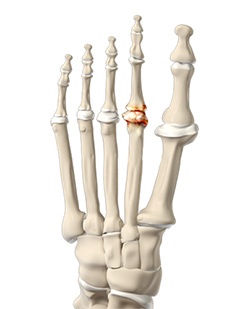Arthritis is inflammation resulting from the degeneration of cartilage in the joint causing pain, swelling, and stiffness in the joints resulting in restricted movements. Arthritis of the foot and ankle joint can occur due to fracture, dislocation, inflammatory disease, or congenital deformity.

The foot joints most commonly affected by arthritis are:
- The joint between the shin bone (tibia) and ankle bone (talus)
- The three joints of the foot that include the heel bone, the inner mid-foot bone, and the outer mid-foot bone
- The joint of the great toe and foot bone
Osteoarthritis: Also called degenerative joint disease, this is the most common type of Arthritis, which occurs most often in older people. This disease affects cartilage, the tissue that cushions and protects the ends of bones in a joint. With osteoarthritis, the cartilage starts to wear away over time. In extreme cases, the cartilage can completely wear away, leaving nothing to protect the bones in a joint, causing bone-on-bone contact. Bones may also bulge, or stick out at the end of a joint, called a bone spur.
Symptoms
Symptoms of foot and ankle arthritis include pain or tenderness, swelling, and stiffness in the joint and limited range of motion.
Diagnosis
The diagnosis of foot and ankle arthritis is made with a medical history, physical examination and X-rays of the affected joint. A bone scan, computed tomography (CT) scans and magnetic resonance imaging (MRI) scans are also performed to diagnose arthritis.
Treatment options
Nonsurgical treatment options for foot and ankle arthritis include medications (anti-inflammatories), injections (steroids), physical therapy, ankle-foot orthosis (AFO), weight loss, orthotics such as pads or arch supports, and canes or braces to support the joints.
Surgery may be required to treat foot and ankle arthritis, if your symptoms do not get better with conservative treatments. Surgery performed for arthritis of the foot and ankle includes:
Arthroscopic surgery: Arthroscopy is a surgical procedure during which the internal structure of a joint is examined for diagnosis and treatment of problems inside the joint. In arthroscopic examination, a small incision is made in the patient’s skin through which pencil-sized instruments that have a small lens and lighting system (arthroscope) are passed. Arthroscope magnifies and illuminates the structures of the joint with the light that is transmitted through fiber optics. It is attached to a television camera and the interior of the joint is seen on the television monitor. Your surgeon can then use probes, forceps, knives, and shavers, to clean the joint area of foreign tissue, inflamed tissue, or bony outgrowths (spurs).
Arthroplasty or Joint Replacement: In this procedure, your surgeon removes the damaged ankle joint and replaces it with an artificial implant. It is usually performed when the joint is severely damaged by osteoarthritis. The goal of ankle replacement is to relieve pain and restore the normal function of the ankle joint.
Arthrodesis: A fusion, also called an arthrodesis involves fusing the bones of the joint together using metal wires or screws.
Your surgeon will discuss the options and help you decide which type of surgery is the most appropriate for you.
Rehabilitation
Following surgery, a rehabilitation program, often involving a physical therapist may help to regain strength and movement. You may need to restrict activities for a minimum of 12 weeks to let the joint reconstruction heal properly. Although recovery is slow, you should be able to resume your normal activities within few months of surgery.
